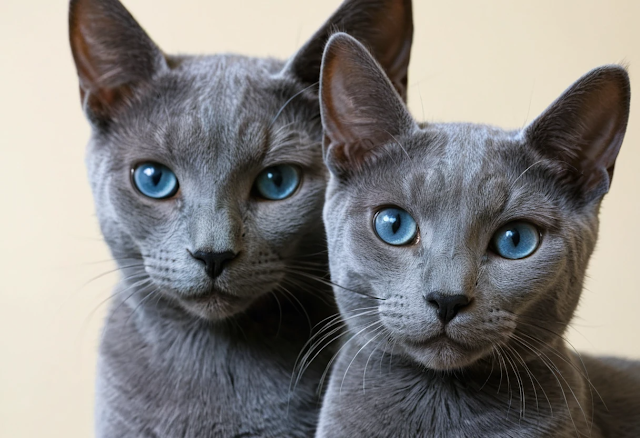Blue Elegance: Russian Cats Unveiled in Every Whisker's Grace!
Blue Elegance: Russian Cats Unveiled in Every Whisker's Grace!
The allure of Russian cats, particularly the Russian Blue breed, captivates cat lovers around the globe. Known for their striking blue-gray coats, vivid green eyes, and gentle demeanor, these felines embody elegance and grace. This article delves into the history, characteristics, care, and unique traits of Russian Blue cats, showcasing why they are cherished companions and a symbol of beauty in the feline world.
A Brief History of the Russian Blue
The origins of the Russian Blue cat are steeped in mystery and folklore. Believed to have originated in Russia, these cats were first documented in the late 19th century. They were showcased at cat shows in England, where they quickly gained popularity due to their stunning appearance and gentle temperament. The breed's history is often intertwined with tales of Russian royalty, suggesting that they were favored companions of the aristocracy.
During the early 20th century, the Russian Blue faced challenges due to the upheaval of the Russian Revolution. Many cats were lost or abandoned, and the breed nearly faced extinction. However, dedicated breeders worked tirelessly to revive the breed, and by the mid-20th century, the Russian Blue was re-established and recognized by various cat registries.
Physical Characteristics
Coat and Color
The most distinguishing feature of the Russian Blue is its plush, double-layered coat. The outer layer is soft and silky, while the undercoat is dense and provides insulation. The coat's color is a unique bluish-gray, often described as "blue" rather than gray, with a shimmering quality that catches the light beautifully. This striking hue is a result of a genetic mutation that affects the pigmentation of the fur.
Eyes
Russian Blues are known for their vivid green eyes, which stand out against their blue-gray fur. The eye color can vary slightly in shade, ranging from a bright emerald to a deeper green, but the intensity of the color is a hallmark of the breed. Kittens are born with yellow eyes, which gradually change to green as they mature.
Body Structure
Russian Blues are medium-sized cats with a muscular build. They have a graceful, athletic appearance, characterized by long legs and a slender neck. Their heads are shaped like a wedge, with a flat forehead and prominent cheekbones. The ears are large and pointed, adding to their alert and intelligent expression.
Temperament and Behavior
Gentle and Affectionate
One of the most appealing traits of Russian Blues is their gentle and affectionate nature. They are known for forming strong bonds with their human companions and often seek out attention and affection. Unlike some breeds that may be overly demanding, Russian Blues are typically calm and enjoy spending time with their families without being overly clingy.
Intelligent and Playful
Russian Blues are highly intelligent cats, known for their curiosity and playful demeanor. They thrive on mental stimulation and enjoy interactive playtime with their owners. Puzzle toys, feather wands, and laser pointers are excellent ways to engage their minds and keep them entertained. Their playful nature often continues into adulthood, making them a joy to have around.
Reserved Yet Social
While Russian Blues are affectionate, they can also be somewhat reserved, especially around strangers. They tend to be cautious and may take time to warm up to new people. However, once they feel comfortable, they are friendly and sociable. Their calm demeanor makes them suitable for families with children and other pets, as they are generally tolerant and adaptable.
Care and Maintenance
Grooming
The Russian Blue's double coat requires regular grooming to keep it in top condition. Weekly brushing is typically sufficient to remove loose hair and prevent matting. During shedding seasons, more frequent grooming may be necessary. Despite their luxurious coat, Russian Blues are known for being relatively low-shedding, making them a good choice for allergy sufferers.
Nutrition
A balanced diet is essential for maintaining the health and vitality of a Russian Blue. High-quality cat food that meets their nutritional needs is crucial. Owners should consult with their veterinarian to determine the best diet for their cat's age, weight, and activity level. Fresh water should always be available, and treats should be given in moderation.
Health Considerations
Russian Blues are generally healthy cats, but like all breeds, they can be prone to certain health issues. Regular veterinary check-ups are essential for monitoring their health and catching any potential problems early. Common health concerns for Russian Blues include obesity, dental issues, and certain genetic conditions. Keeping them active and maintaining a healthy diet can help mitigate these risks.
The Russian Blue in Popular Culture
The Russian Blue has made its mark in popular culture, appearing in various forms of media and literature. Their striking appearance and graceful demeanor have made them a favorite among filmmakers and authors. In the animated film "The Aristocats," a character named Duchess bears a striking resemblance to the Russian Blue, showcasing the breed's elegance and charm.
Additionally, Russian Blues have been featured in numerous books and stories, often symbolizing mystery and grace. Their association with royalty and aristocracy has further solidified their status as a beloved breed.
The Russian Blue cat is a true embodiment of elegance and grace, captivating the hearts of cat lovers worldwide. With their stunning blue-gray coats, vivid green eyes, and gentle personalities, they make exceptional companions. Their rich history, unique characteristics, and affectionate nature contribute to their enduring popularity.
Whether you are considering adding a Russian Blue to your family or simply appreciate their beauty, there is no denying the charm and allure of these remarkable felines. As we continue to celebrate the elegance of the Russian Blue, we are reminded of the joy and companionship that these cats bring into our lives, one whisker's grace at a time.
.jpg)









